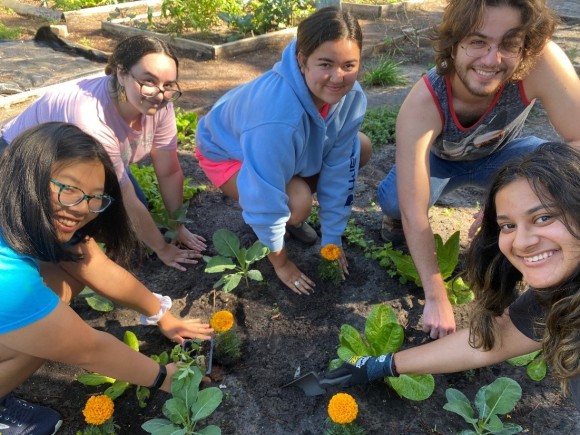Inside the classroom: Sustainability in the Urban Environment grows active learning in an interconnected world – News · Lafayette College

Report on Lafayette College Course EVST 375: An Integrated Approach to the Sustainable Development Goals
Executive Summary
The Lafayette College course, EVST 375: Sustainability in the Urban Environment, serves as a practical model for integrating the United Nations Sustainable Development Goals (SDGs) into higher education. Taught by Professor Ernest Nkansah-Dwamena, the course utilizes an evolving curriculum and active learning methodologies to connect theoretical knowledge with real-world challenges. By focusing on the local urban environment of Easton, Pennsylvania, the course directly addresses multiple SDGs, preparing students to be active agents of change. This report outlines the course’s structure, its alignment with key SDGs, and its impact on student learning and community engagement.
Curriculum Design and Pedagogical Framework
Alignment with Sustainable Development Goals
The core of EVST 375 is designed to explore the complex interdependencies of urban environments and sustainability, directly reflecting the ambitions of the 2030 Agenda. The curriculum’s primary focus is on SDG 11: Sustainable Cities and Communities, examining how urban centers can be made inclusive, safe, resilient, and sustainable. Key topics systematically address a range of interconnected goals:
- Biophilic Design and Green Infrastructure: These topics directly support SDG 11 by promoting sustainable urban planning. They also contribute to SDG 13 (Climate Action) through urban heat island mitigation and SDG 15 (Life on Land) by integrating nature into cityscapes.
- Urban Food Systems: Analysis of local food systems and food sovereignty initiatives connects directly to SDG 2 (Zero Hunger), aiming to ensure access to safe and nutritious food for urban populations.
- Housing Justice: This component addresses critical targets within SDG 11 related to ensuring access for all to adequate, safe, and affordable housing.
- Water Management: Engagement with municipal departments on issues like storm drainage directly relates to SDG 6 (Clean Water and Sanitation), specifically the sustainable management of water resources in urban settings.
Pedagogy for Quality Education (SDG 4)
Professor Nkansah-Dwamena employs an innovative pedagogical approach that embodies the principles of SDG 4: Quality Education. The methodology is designed to foster critical thinking, collaboration, and lifelong learning skills essential for sustainable development.
- Active Learning: Students engage in group projects, debates, and role-playing exercises that mirror real-world problem-solving, moving beyond passive lecture-based learning.
- Reflexive Practice: An “ungrading policy” shifts focus from performance metrics to personal growth and self-reflection. This encourages deeper intellectual engagement and critical thinking.
- Mindfulness: The integration of mindfulness exercises at the beginning of class supports student well-being and enhances their capacity to engage with complex and challenging subject matter.
Experiential Learning and Community Partnership (SDG 17)
The City as a Living Laboratory
The course utilizes the City of Easton as a case study, grounding abstract sustainability concepts in the tangible realities of a local community. This approach demonstrates that meaningful progress toward the SDGs can begin at the neighborhood level. Students are challenged to analyze Easton’s future, applying their learning to real-world local issues.
Field Engagement and Strategic Partnerships
A central component of the course involves field trips and interactions with local organizations, exemplifying SDG 17: Partnerships for the Goals. These hands-on experiences provide students with direct insight into the practical implementation of sustainability initiatives.
- Easton Garden Works: A visit to the Lower Hackett Community Garden, run by this organization, provides a direct look at grassroots efforts to advance SDG 2 (Zero Hunger) and SDG 11 (Sustainable Cities and Communities) by providing fresh produce and fostering community green spaces.
- Municipal Collaboration: Discussions with the City of Bethlehem’s storm drainage department offer practical insights into the management of urban water systems, a key target of SDG 6 (Clean Water and Sanitation).
According to student Charlotte Farrelly ’26, these field experiences are instrumental in understanding how “an increase in green infrastructure can directly increase the quality of life for millions of people living in cities by fostering community,” a core objective of SDG 11.
Conclusion: Cultivating Future Leaders for Sustainable Development
EVST 375 demonstrates that higher education can play a pivotal role in advancing the Sustainable Development Goals. By combining a robust, SDG-aligned curriculum with an active, community-engaged learning model, the course equips students with the knowledge, skills, and civic perspective necessary to address complex sustainability challenges. It underscores the principle that achieving a sustainable future is an interdisciplinary effort that requires the engagement of all citizens and future professionals.
Which SDGs are addressed or connected to the issues highlighted in the article?
-
SDG 2: Zero Hunger
The article addresses SDG 2 through its discussion of “food systems” and “food sovereignty.” The field trip to the Lower Hackett Community Garden, which “provides fresh produce for the local community,” directly connects to improving local food access and promoting sustainable agriculture within an urban context.
-
SDG 4: Quality Education
The entire article is centered on the EVST 375 course, which exemplifies SDG 4. It focuses on providing education for sustainable development by using active learning, real-world problem-solving, and critical thinking. The course aims to equip students with the “knowledge and skills needed to promote sustainable development,” as stated in Target 4.7.
-
SDG 6: Clean Water and Sanitation
This goal is connected through the mention of a field trip where students engage with the “storm drainage department in the City of Bethlehem.” This points to the management of urban water resources, a key component of sustainable city infrastructure and integrated water management.
-
SDG 11: Sustainable Cities and Communities
This is the most prominent SDG in the article. The course “Sustainability in the Urban Environment” directly tackles themes central to SDG 11, including “green infrastructure,” “housing justice,” “city planning,” and the creation of public green spaces like community gardens to “increase the quality of life for millions of people living in cities.”
-
SDG 15: Life on Land
The article connects to SDG 15 by exploring how cities can function as ecosystems and engage with the natural world. Course topics like “biophilic design” and “green infrastructure” are practical examples of integrating ecosystem and biodiversity values into urban planning, which is a key aspect of protecting life on land.
What specific targets under those SDGs can be identified based on the article’s content?
-
Target 2.1: End hunger and ensure access to safe, nutritious and sufficient food
This target is identified through the course’s focus on “food systems” and “food sovereignty.” The example of the Easton Garden Works urban farm, which “provides fresh produce for the local community,” is a direct effort to ensure local access to nutritious food.
-
Target 4.7: Education for sustainable development and global citizenship
The EVST 375 course is a direct implementation of this target. Professor Nkansah-Dwamena’s teaching philosophy, which emphasizes applying knowledge in “real-world contexts” and inspiring students to “rethink their role as citizens and future professionals,” aims to provide education for sustainable development.
-
Target 6.5: Implement integrated water resources management
The mention of students “talking with the storm drainage department” and learning about “green infrastructure” relates to this target. These topics are fundamental to managing water resources, particularly stormwater, in an integrated and sustainable way within an urban environment.
-
Target 11.1: Ensure access to adequate, safe and affordable housing
This target is explicitly mentioned as a course topic under the term “housing justice,” indicating that students investigate the challenges and solutions related to equitable and sustainable housing in urban centers.
-
Target 11.3: Enhance inclusive and sustainable urbanization and planning
The course encourages this by using Easton as a “living case study” where students “tackle real questions about Easton’s future.” This hands-on approach to “city planning” promotes a participatory and integrated method for sustainable urban development.
-
Target 11.7: Provide universal access to safe, inclusive and accessible, green and public spaces
This target is highlighted by the field trip to the Lower Hackett Community Garden, which gives residents “an opportunity to maintain their own green space.” The article also notes that an “increase in green infrastructure can directly increase the quality of life” by fostering community, which aligns with the goal of creating accessible public spaces.
-
Target 15.9: Integrate ecosystem and biodiversity values into local planning
The inclusion of “biophilic design” and “green infrastructure” as core topics in the curriculum directly supports this target. These concepts are about embedding nature and ecosystem services into the fabric of urban planning and development.
Are there any indicators mentioned or implied in the article that can be used to measure progress towards the identified targets?
-
Implied Indicator for Target 2.1: Existence and support of urban agriculture initiatives
The article points to the “Lower Hackett Community Garden” run by “Easton Garden Works” as a tangible initiative. The presence and success of such urban farms serve as an indicator of progress in strengthening local food systems and food sovereignty.
-
Implied Indicator for Target 4.7: Number of educational courses on sustainable development
The existence of the “EVST 375: Sustainability in the Urban Environment” course itself is an indicator. The number of students enrolled and the integration of such courses across “all departments at Lafayette” could be used to measure the mainstreaming of education for sustainable development.
-
Implied Indicator for Target 11.3: Structures for direct participation in urban planning
The course itself functions as a mechanism for participation, where students “tackle real questions about Easton’s future.” This educational model, which engages future professionals in local issues, can be seen as an indicator of capacity-building for participatory planning.
-
Implied Indicator for Target 11.7: Area of public green space
The article implies this indicator through its discussion of an “increase in green infrastructure” and the example of the community garden as a “green space.” The development of “multiuse lots” and community gardens can be measured as an increase in the proportion of land dedicated to public green use.
-
Implied Indicator for Target 15.9: Integration of biodiversity in local planning strategies
The inclusion of “biophilic design” in the course curriculum is an indicator that principles of biodiversity are being integrated into the education of future planners and professionals. The adoption of such designs in city projects would be a direct measure of progress.
SDGs, Targets, and Indicators Analysis
| SDGs | Targets | Indicators (Mentioned or Implied) |
|---|---|---|
| SDG 2: Zero Hunger | 2.1: End hunger and ensure access to safe, nutritious and sufficient food. | Existence and community use of urban farms and gardens (e.g., Lower Hackett Community Garden). |
| SDG 4: Quality Education | 4.7: Education for sustainable development and global citizenship. | Availability of specialized courses on sustainability (e.g., EVST 375) that use active, real-world learning. |
| SDG 6: Clean Water and Sanitation | 6.5: Implement integrated water resources management. | Educational engagement with municipal water management (e.g., storm drainage department) and study of green infrastructure for water control. |
| SDG 11: Sustainable Cities and Communities | 11.1: Ensure access to adequate, safe and affordable housing. | Inclusion of “housing justice” as a key topic in urban studies curriculum. |
| 11.3: Enhance inclusive and sustainable urbanization and planning. | Use of local cities as “living case studies” for students to engage in participatory planning exercises. | |
| 11.7: Provide universal access to safe, inclusive and accessible, green and public spaces. | Development of community gardens and an “increase in green infrastructure” and “multiuse lots.” | |
| SDG 15: Life on Land | 15.9: Integrate ecosystem and biodiversity values into local planning. | Inclusion of “biophilic design” and “green infrastructure” in educational programs and city planning discussions. |
Source: news.lafayette.edu

What is Your Reaction?
 Like
0
Like
0
 Dislike
0
Dislike
0
 Love
0
Love
0
 Funny
0
Funny
0
 Angry
0
Angry
0
 Sad
0
Sad
0
 Wow
0
Wow
0












































































